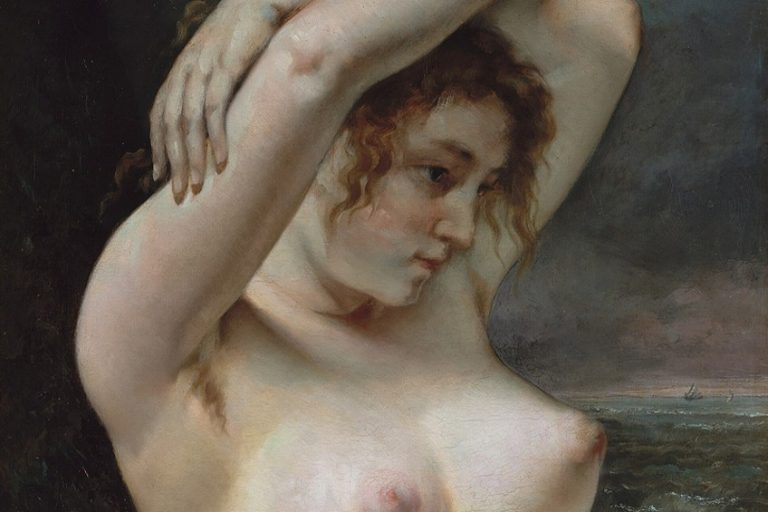“Interior” by Edgar Degas – A Famous Painting Analysis
Interior, a compelling and enigmatic work by Edgar Degas, stands out as a unique piece within his diverse oeuvre. Painted between 1868 and 1869, this oil on canvas diverges from Degas’ typical themes of ballet dancers and horse races, presenting instead a dramatic, dimly lit domestic scene. Often referred to as The Rape, the painting depicts a tense and ambiguous moment between a man and a woman in a bourgeois interior, evoking a sense of mystery and psychological depth. This work exemplifies Degas’ masterful use of light and shadow to convey mood and narrative, highlighting his interest in human emotion and the complexities of interpersonal relationships. Through its unsettling atmosphere and intricate details, Interior invites viewers to speculate on the story and emotions underlying the depicted scene, showcasing Degas’ profound ability to capture the intricacies of human experience.
Key Takeaways
- Interior is a pivotal work by Edgar Degas, distinct for its dramatic narrative and emotional intensity.
- The painting is preserved and displayed at the Philadelphia Museum of Art, where it continues to intrigue viewers and scholars.
- Degas’s artwork provides a vital understanding of 19th-century social dynamics and contributes to the ongoing discourse in art analysis and historical significance.
Historical and Cultural Significance
| Artist | Edgar Degas (1834 – 1917) |
| Date Created | 1868 – 1869 |
| Medium | Oil on canvas |
| Genre | Impressionism |
| Period/Movement | 19th Century |
| Dimensions (cm) | 81.3 x 114.3 |
| Series/Versions | None |
| Where Is It Housed? | Philadelphia Museum of Art, Philadelphia, United States |
| What It Is Worth | Varies |
Interior, also known by the name The Rape, is a significant work by the French artist Edgar Degas, created between 1868 and 1869. This piece differs from Degas’s more familiar studies of ballet dancers and racetracks; it instead offers a glimpse into a private, ambiguous, and possibly confrontational moment between a man and a woman. With shadows and lamplight playing across the scene, the tension in the room is palpable, making the work one of Degas’s most enigmatic and discussed canvases.

Housed at the Philadelphia Museum of Art, Interior is often the subject of intense scrutiny by art historians and critics alike. The painting’s complex narrative content, combined with Degas’s masterful understanding of light and psychological depth, renders a tableau that resists easy interpretation. This resistance to clear interpretation adds to its allure and enduring interest in the art world.
While suggestions have been made that it may take inspiration from the troubled relationships depicted in novels by Émile Zola, Interior stands as a prime example of Degas’s broader artistic explorations, offering significant insights into the socio-cultural layers of the late 19th century.
Degas’s Influence on Modern Art
Edgar Degas, a towering figure in the Impressionist movement, profoundly influenced modern art with his unique approach to composition and subject matter. Interior is no exception. With Degas’s characteristic use of theatrical lighting and off-center framing, this artwork presents a narrative that seems both immediate and enigmatic. It challenges viewers to look beyond the impressionist style’s concern with light and color, diving into the psychological depth of the portrayed figures—a practice that would echo through the works of countless artists who followed.

Relation to Historical Events
While Interior does not depict a specific historical event, Degas’s contemporaries might have recognized in it the influences of Parisian modern life and literature. For instance, parallels are often drawn between Degas’s scene and the naturalistic works of French author Émile Zola. Some suggest that Interior could be illustrating a moment from Zola’s novel, Thérèse Raquin, a notion that situates the painting within the broader societal narratives of late 19th-century Paris.
Additionally, the ominous and ambiguous interaction between the man and woman in the painting could be seen as a social commentary, reflective of the issues of power and gender dynamics that were being examined during that era.
Artistic Context of Interior
Interior by Hilaire-Germain-Edgar Degas is a provocative painting known among art historians for its enigmatic narrative and compositional skill. Degas, primarily associated with the Impressionists, diverges in this piece with a more Realist influence, marked by its narrative depth and trompe-l’oeil detail. The artwork exhibits a departure from the Impressionists’ focus on light and color. Instead, Degas explores the psychological drama between characters. This intensity aligns closely with the Naturalist themes found in the novels of Émile Zola, suggesting a possible literary source for the painting’s subject matter.

Scholars surmise that Degas may have drawn inspiration from Zola’s narratives that depict complex human relationships. The tension in the scene resonates with the dark realism and intricate interpersonal dynamics characteristic of Zola’s work. Unlike Degas’s typical subjects, like ballerinas and racehorses, Interior captures a private, fraught moment. Critics and art historians alike regard Interior as an outlier in Degas’s oeuvre that stands as a testament to his skill beyond his association with the Impressionists.
Its layered narrative and execution demonstrate a complex interaction of artistic movements during a vibrant period of art history.
Analysis of the Painting
Degas’s Interior also known as The Rape, is a complex oil painting on canvas that masterfully explores tension through color, light, composition, and symbolism. The following analysis breaks down these crucial elements to understand the artwork’s impact and meaning.

Color and Subject Matter
The color palette of Interior predominantly features somber and muted tones which set a heavy and tense atmosphere within the room depicted. The most striking use of color is seen in the woman’s attire, the stark white of her corset, and the deep red of the parasol, which stand in contrast to the darkness of the setting.
The subject matter, a confrontation between a man and a partially undressed woman next to a bed in a dimly lit room, fuels a narrative of conflict and suspicion.

Use of Light and Composition
Degas’s manipulation of light showcases his realist tendencies and dramatic flair. The source of light, a lamp, casts shadows that play a significant role in the composition, emphasizing the confrontational stance of the figures and creating a stage-like setting.
The theatrical use of lamplight accentuates the woman’s distress and the man’s imposing presence, invoking a sense of a private scene witnessed by the viewer.

Symbolic Elements
Interior is ripe with symbolism. Objects like the sewing box, the corset, and the parasol contribute to the narrative’s suspense, potentially indicating the woman’s domestic occupation and the invasive disruption of her space.
The positioning of the figures and the scattered personal items suggest a narrative beyond a mere domestic quarrel, hinting at deeper social commentaries.

Meaning of the Artwork
Without definitive textual sources, the painting has been open to interpretations that range from illustrating scenes from literature to symbolizing the imbalance of power between sexes. Located at the Philadelphia Museum of Art, Interior invites viewers to contemplate the realism of human interactions and the role of gender dynamics within a societal context.
The unsettled nature of the room and the ambiguous relationship between the characters suggest a narrative exploration often found in theatrical works.

Influence of Interior Today
Interior continues to invoke discussion and analysis among art historians and enthusiasts. The ambiguous narrative and dramatic tension in the piece have made it a fascinating subject for modern interpretation and study. Degas’ work has had a lasting impact on contemporary painters and visual artists, who frequently cite his masterful use of lighting and psychological depth as significant influences.
The painting’s complex narrative approach is widely studied in art schools, inspiring new artists to push the boundaries of conventional storytelling and delve into more intricate and evocative depictions of human experience.
Interior is often examined in conjunction with theatrical productions and literary works due to its potential references to French literature. Academics delve into the painting’s narrative through essays and articles, highlighting its enduring relevance in discussions of gender dynamics and power struggles. This cross-disciplinary analysis underscores the depth and complexity of Degas’ work, cementing its significance in both art history and broader cultural studies.

Museums and galleries frequently feature Interior in exhibitions focused on Impressionism and narrative painting, emphasizing its historical significance. The piece often serves as a centerpiece in discussions about Degas’ broader oeuvre, providing valuable insights into the societal and cultural context of late 19th-century France. Its continued prominence in exhibitions and collections highlights its enduring impact and relevance in the art world.
Edgar Degas’ Interior remains a powerful testament to his ability to convey complex emotional narratives through art. This evocative painting, with its masterful interplay of light and shadow, breaks away from Degas’ more familiar subjects to explore themes of tension and psychological depth. The ambiguity and drama encapsulated within this domestic scene invite endless interpretation, ensuring its enduring fascination for viewers and art historians alike. Interior not only demonstrates Degas’ technical prowess but also his keen insight into the human condition, solidifying its place as a significant and intriguing work in his artistic legacy.
Frequently Asked Questions
What Is the Symbolism Behind Interior by Edgar Degas?
Interior, also known as The Rape, is marked by an ambiguous symbolism that portrays a tense confrontation between a man and a woman. The exact symbolism is debated among art historians, with some suggesting it may imply a narrative of power, violation, or a social commentary on Parisian life in the late 19th century.
How Does Interior Compare to Edgar Degas’ Other Works?
Compared to Degas’ renowned ballerina paintings, which often exude a sense of grace and movement, Interior is strikingly different. It presents a static and psychologically charged scene, contrasting greatly with the dynamism and public spectacle associated with his depictions of dancers.
What Artistic Techniques Did Edgar Degas Employ in the Creation of Interior?
In Interior, Degas employs strong chiaroscuro, with dramatic lighting creating deep shadows that enhance the painting’s tension. His use of oil on canvas allows for rich texture and contrast, which contribute to the work’s enigmatic quality.
What Is the Historical Context of Edgar Degas’ Painting, Interior?
Painted between 1868 and 1869, Interior emerges against the backdrop of the Parisian art scene of the late 19th century. It was a period marked by a shift towards modernity, and Degas’ work often reflected the societal changes and urban narratives of that era. “Interior” presents a moment in time that has sparked extensive analysis and interpretation due to its complex and mysterious subject matter.
Isabella studied at the University of Cape Town in South Africa and graduated with a Bachelor of Arts majoring in English Literature & Language and Psychology. Throughout her undergraduate years, she took Art History as an additional subject and absolutely loved it. Building on from her art history knowledge that began in high school, art has always been a particular area of fascination for her. From learning about artworks previously unknown to her, or sharpening her existing understanding of specific works, the ability to continue learning within this interesting sphere excites her greatly.
Her focal points of interest in art history encompass profiling specific artists and art movements, as it is these areas where she is able to really dig deep into the rich narrative of the art world. Additionally, she particularly enjoys exploring the different artistic styles of the 20th century, as well as the important impact that female artists have had on the development of art history.
Learn more about Isabella Meyer and the Art in Context Team.
Cite this Article
Isabella, Meyer, ““Interior” by Edgar Degas – A Famous Painting Analysis.” Art in Context. May 30, 2024. URL: https://artincontext.org/interior-by-edgar-degas/
Meyer, I. (2024, 30 May). “Interior” by Edgar Degas – A Famous Painting Analysis. Art in Context. https://artincontext.org/interior-by-edgar-degas/
Meyer, Isabella. ““Interior” by Edgar Degas – A Famous Painting Analysis.” Art in Context, May 30, 2024. https://artincontext.org/interior-by-edgar-degas/.











